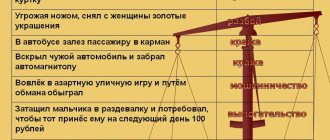Every resident of the country needs to know the basic aspects of criminal law. Such types of theft as robbery (Article 162, Chapter 21 of the Criminal Code of the Russian Federation), theft (Article 158, Chapter 21 of the Criminal Code of the Russian Federation), and robbery (Article 161, Chapter 21 of the Criminal Code of the Russian Federation) are known to everyone. However, not each of us distinguishes between these types of crimes.
Yes, they are all placed in one chapter of the Criminal Code of the Russian Federation - “Crimes against property” (Chapter 21 of the Criminal Code of the Russian Federation) and are united by one goal - the illegal gratuitous seizure of someone else’s property without the subsequent return of the item to its owner. But each of these crimes has a lot of features - let's look at them in detail.
Secret theft of someone else's property - theft
According to Article 158 of the Criminal Code of the Russian Federation, theft is the secret theft of someone else's property. The peculiarity of theft is that the thing is seized in the absence of its owner and without any witnesses OR if the offender was noticed by the owner or witnesses, but believed that the crime would go unnoticed.
For example, if his actions were filmed on a hidden camera or were noticed by neighbors from the window. A crime is also called theft if it occurs in the presence of witnesses or the owner of the thing , but they are unaware of the evil intention of the criminal. For example, if a visiting guest turns out to be a criminal who stole property in the house.
Open appropriation - robbery
According to Article 161 of the Criminal Code of the Russian Federation, robbery is the open theft of someone else's property. This type of crime against property is committed in the presence of the owner of the property or strangers who take measures to suppress the crime or are simply witnesses.
The main condition is that those present must understand the illegality of the action. Robbery differs from robbery by the use of violence, which does not threaten the life or health of the victim or its complete absence.
How are they different from each other?
The distinction should be made based on the following characteristics.
| Theft | Robbery | Robbery | |
| Having a desire to remain unnoticed | the criminal wants to remain undetected | the criminal's actions are carried out openly and with complete disregard for their illegality | the criminal also commits acts openly |
| Use of violence | violence is not used in any form | violence is either absent or used without threat to the life and health of the victim | the use of violence is mandatory |
| Level of responsibility | punishable by imprisonment for a term of up to five years or compulsory labor for a term of up to 480 hours and a fine | punishable by forced labor for a term of up to five years or imprisonment for a term of up to five years and a fine | punishable by imprisonment for up to ten years and a fine |
What are the differences between theft and robbery?
The differences between theft and larceny are:
- the theft is carried out secretly and the thief makes every effort to remain unnoticed; during robbery, he acts boldly and openly;
- during theft, violence is unacceptable, and during a robbery it can be used against the owner, but not dangerous to his health or life (for example, a criminal may push the victim away while fleeing, or a person may fall when his purse is suddenly snatched from him). But threats or obvious harm to the victim during robbery are not allowed.
If you still have questions on this topic, we recommend that you contact our lawyers by phone or online.
Composition of theft
The object of the crime is social relations that develop in the sphere of distribution and redistribution of material goods and belong to the category of “property”. Theft does not entail the loss of the owner's right to the property seized from him during the crime, and the person who committed the theft does not have the right of ownership to the stolen property. Any form of disposal of stolen goods is illegal.
The subject of the crime is a sane individual who has reached the age of 14 (how the crime is classified and what is the responsibility for it if the theft is committed by a person under 14 years of age, read here).
The subject of theft is someone else's property.
The purpose of the crime is the action of the perpetrator for the gratuitous and deliberately unlawful appropriation of someone else’s property.
The intent is self-interest.
The motive is direct.
The objective side of the crime is the actions of the perpetrator in the material world, aimed at confiscating someone else’s property and turning it into one’s own benefit or the benefit of other persons.
Theft is considered secret if:
- it is carried out in the absence of the owner of the property and/or unauthorized persons;
- it is performed in the presence of the owner and/or unauthorized persons, but unnoticed by them;
- the owner or other persons saw the crime being committed, but the offender believed that his actions were invisible;
- it is committed in the presence of people who cannot realize the illegality of the action due to any circumstances (mentally ill, sleeping, children, heavily drunk, fainting);
- it is committed in the presence of relatives or loved ones of the criminal, who are aware of the illegality of the action, but the criminal believes that they will not oppose him.
Consequence : causing property damage to the victim.
Subjective side of the crime : guilt in the form of direct intent and selfish purpose.
Construction of the crime : material composition.
The crime is considered completed when the perpetrator has stolen someone else's property and has a real opportunity to use it and dispose of it as he wishes.
For more information about the elements of the crime, as well as what factors are considered as objective and subjective signs of theft, read this material.
Example
The criminal quietly entered the apartment of an elderly woman at night while she was sleeping and stole valuable documents and jewelry. He appropriated the woman’s property and went unnoticed - the crime took place.
What to do in such situations, if your documents were stolen, you will learn from this material.
Responsibility
Theft without qualifying characteristics is punishable (according to Part 1 of Article 158 of the Criminal Code of the Russian Federation):
- a fine in the amount of up to eighty thousand rubles or in the amount of the wages or other income of the convicted person for a period of up to six months;
- or compulsory work for a period of up to three hundred and sixty hours;
- or correctional labor for up to one year;
- or restriction of freedom for a term of up to two years;
- or forced labor for up to two years;
- or arrest for up to four months;
- or imprisonment for a term of up to two years.
The first group of qualifying signs of theft includes:
- commission of a crime by a group of persons by prior conspiracy;
- committing a crime involving illegal entry into a premises or other storage facility;
- commission of a crime causing significant damage to the victim;
- committing theft from a bag or other carry-on luggage that was with the victim, from clothing (you can learn more about pickpocketing here).
These types of theft are punishable (according to Part 2 of Article 158 of the Criminal Code of the Russian Federation):
- a fine in the amount of up to two hundred thousand rubles or in the amount of wages or other income of the convicted person for a period of up to eighteen months;
- or compulsory work for a period of up to four hundred eighty hours;
- or correctional labor for up to two years;
- or forced labor for up to five years with or without restriction of freedom for up to one year;
- or imprisonment for a term of up to five years with or without restriction of freedom for a term of up to one year.
The following qualifying signs of theft include:
- committing theft with illegal entry into a home;
- committing theft from an oil pipeline, oil product pipeline, gas pipeline;
- committing grand theft;
- committing theft from a bank account;
- committing theft in relation to electronic funds.
In this case, theft is punishable (according to Part 3 of Article 158 of the Criminal Code of the Russian Federation):
- a fine in the amount of one hundred thousand to five hundred thousand rubles or in the amount of wages or other income of the convicted person for a period of one to three years;
- or forced labor for a period of up to five years with or without restriction of freedom for a period of up to one and a half years;
- or imprisonment for a term of up to six years with a fine of up to eighty thousand rubles;
- or in the amount of wages or other income of the convicted person for a period of up to six months or without it and with restriction of freedom for a period of up to one and a half years or without it.
Qualifying signs of theft also include:
- committing theft by a group;
- committing theft on an especially large scale.
These types of theft are punishable (according to Part 4 of Article 158 of the Criminal Code of the Russian Federation):
- imprisonment for a term of up to ten years with a fine of up to one million rubles;
- or in the amount of wages or other income of the convicted person for a period of up to five years or without it and with restriction of freedom for a period of up to two years or without it.
We tell you more about what punishment for theft is provided for under Article 158 of the Criminal Code of the Russian Federation in a special article.
Types of crime
A crime such as robbery is classified mainly by the degree of cruelty, the number and age of persons who participated in the crime, and the presence of weapons. When considering a case, all these factors are taken into account using a differentiated method, depending on the conditions and characteristics of the actions. Let's look at the most common types of robbery:
- Property. This type of robbery, in terms of severity, is the most loyal to the victim. It is he who is considered basic in legal practice. It is worth noting that property robbery does not imply any physical violence against the victim and is exclusively enriching in nature.
- Armed. Robbery with the use of a weapon is qualified even if it was not used in the attack. Judicial practice stipulates that the presence of weapons implies that the criminals planned the attack taking into account their possible use. In addition, any object that could have caused injury to the victim is also considered a weapon (bottles, pipes, stones, etc.).
- With penetration. A significant aggravation of the robbery itself is the fact that criminals enter private territory. Accordingly, they suffer harsher punishment.
Separately, it is necessary to consider the subcategory of robbery with murder. Such crimes are considered the most cruel and are punishable by the highest degree of punishment provided for by law. Depending on the conditions under which the crime was committed, the following types are distinguished:
- On the roads. This type of robbery is most often committed with the aim of stealing funds in the possession of the driver or the vehicle itself.
- By a group of persons by prior conspiracy. It is this type of crime that is most often associated with the murder of the victim. In such cases, the use of weapons, as well as the absence of them, is possible.
- Nautical. As a rule, this type of robbery involves not only fairly large thefts, but also a disruption in the regular operation of shipping routes. Accordingly, all this is taken into account in court when passing a sentence.
Thus, robbery covers a fairly wide range of various illegal actions, which somewhat complicates the procedure for its qualification.
Be sure to indicate in the claim all the details that were noticed by you during the attack on you (implying robbery). This will ensure that the offender receives the full punishment, and will also simplify the procedure for considering the case.
Composition of robbery
The object of the crime is social relations that develop in the sphere of distribution and redistribution of material goods and belong to the category of “property”. Robbery is characterized by a complex object, since the attack is carried out not only on relations related to the distribution and redistribution of material goods, but also on the health of the victim.
The subject of the crime is a sane person who has reached the age of 14 and does not have any authority in relation to the stolen property.
The subject of robbery is someone else's property.
The purpose of robbery is the gratuitous seizure of someone else's property for one's own benefit.
The intent is self-interest.
The motive is direct.
The objective side of the crime is the open illegal seizure of property in the presence of the owner or owner, as well as strangers, when the person committing this crime is aware that those present understand the illegal nature of his actions, regardless of whether they took measures to suppress these action or not.
The consequence is causing property damage to the property owner.
The subjective side of the crime is direct intent and selfish purpose.
Construction of the crime - the material elements of the crime.
The crime is considered completed when the criminal has taken possession of someone else’s property and acquired a real opportunity (albeit not legal) to dispose and use the property or destroy it.
Life situation
The criminal approached a passerby, snatched the mobile phone from his hands and ran away. We see that the criminal understands the illegality of his actions and understands that the victim will know about the robbery, that is, the crime will occur in front of the victim.
What to do and where to go if in life you encounter the situation discussed in the example and your mobile phone is stolen, we will tell you in a separate article.
Amount of punishment
Robbery without qualifying characteristics is punishable (according to Part 1 of Article 161 of the Criminal Code of the Russian Federation):
- compulsory work for a period of up to four hundred eighty hours;
- or correctional labor for up to two years;
- or restriction of freedom for a term of two to four years;
- or forced labor for up to four years;
- or arrest for a term of up to six months, or imprisonment for a term of up to four years.
Qualifying features:
- commission of a crime by a group of persons by prior agreement;
- committing a crime with illegal entry into a home, premises or other storage;
- committing a crime with the use of violence that is not dangerous to life and health or with the threat of violence;
- committing robbery on a large scale.
In these cases, robbery is punishable (according to Part 2 of Article 161 of the Criminal Code of the Russian Federation):
- forced labor for up to five years;
- or imprisonment for a term of up to seven years with a fine of up to ten thousand rubles;
- or in the amount of wages or other income of the convicted person for a period of up to one month or without it and with or without restriction of freedom for a period of up to one year.
Another group of aggravating features:
- committing robbery by an organized group;
- on a particularly large scale.
In such cases, the crime is punishable (according to Part 3 of Article 161 of the Criminal Code of the Russian Federation):
- imprisonment for a term of six to twelve years with a fine of up to one million rubles;
- or in the amount of wages or other income of the convicted person for a period of up to five years or without it and with restriction of freedom for a period of up to two years or without it.
Composition of robbery
The object of the crime is social relations that develop in the sphere of distribution and redistribution of material goods and belong to the category of “property”. Robbery is characterized by a complex object, since the attack is carried out not only on relations related to the distribution and redistribution of material goods, but also on the health of the victim.
Subject of the crime : a sane individual who has reached the age of 14 years.
Subject of robbery : other people's property.
Purpose : gratuitous seizure of someone else's property.
Intent : self-interest.
Motive : straight.
The objective side of the crime is expressed, firstly, in the commission of an attack, and secondly, in the mandatory use of violence dangerous to the life and health of the victim, or in the threat of using such violence. Consequently, both attack and the use of physical or mental violence are mandatory elements of robbery.
Subjective side of the crime : guilt in the form of direct intent and selfish purpose.
Construction of the corpus delicti : truncated corpus delicti.
The crime is completed when the offender has committed the attack, even if he was unable to take possession of the property.
Example
You can consider the same example of robbery, only in the case of robbery, the criminal first stabs the victim with a knife and disappears.
Consequences
Robbery committed without qualifying characteristics is punishable (according to Part 1 of Article 162 of the Criminal Code of the Russian Federation):
- forced labor for up to five years;
- or imprisonment for a term of up to eight years with a fine of up to five hundred thousand rubles;
- or in the amount of wages or other income of the convicted person for a period of up to three years or without it.
Committing robbery by a group by prior agreement, as well as with the use of weapons or with the use of objects used as weapons, is punishable (according to Part 2 of Article 162 of the Criminal Code of the Russian Federation):
- imprisonment for a term of up to ten years with a fine of up to one million rubles;
- or in the amount of wages or other income of the convicted person for a period of up to five years or without it and with restriction of freedom for a period of up to two years or without it.
Qualifying features:
- committing robbery with illegal entry into a home, premises or other storage;
- committing robbery on a large scale.
In these cases, the crime is punishable (according to Part 3 of Article 162 of the Criminal Code of the Russian Federation):
- imprisonment for a term of seven to twelve years with a fine of up to one million rubles;
- or in the amount of wages or other income of the convicted person for a period of up to five years or without it and with restriction of freedom for a period of up to two years or without it.
Qualifying features:
- robbery by an organized group;
- committing robbery on an especially large scale;
- causing grievous harm to the victim's health.
In these cases, robbery is punishable (according to Part 4 of Article 162 of the Criminal Code of the Russian Federation):
- imprisonment for a term of eight to fifteen years with a fine of up to one million rubles;
- or in the amount of wages or other income of the convicted person for a period of up to five years or without it and with restriction of freedom for a period of up to two years or without it.
Arbitrage practice
Decisions made by members of the judiciary are regulated by Plenum Resolution No. 29. The following points can be highlighted as key:
- The crime is considered completed at the moment when the defendant takes possession of the property of another citizen.
- The commission of robbery by prior conspiracy by a group of criminals will be recognized only if one person was directly involved in the seizure of property, and the rest helped him in every possible way, for example, opening locks, guarding exits or tying up the victims.
- If the criminal was in the house legally, then the aggravating circumstance of entering someone else’s home will not be applied by the court.
- If the criminal group, in addition to the main defendant, included children under the age of 14, then during the investigation the robbery will be regarded as committed by one defendant. Children under 14 years of age do not have the right to be subjects of a crime in accordance with the current legislation of the Russian Federation.
Resolution of the Plenum of the Supreme Court of the Russian Federation
Resolution No. 29 on judicial practice in cases related to theft, robbery and robbery regulates most judicial procedures. You can study this legislative document using this link.
Basic distinctions
The delimitation of these compositions can be carried out according to the following criteria:
- Danger . During theft and robbery, the actions of the criminal do not pose a danger to the owner or other persons. During robbery, the criminal uses violence against the victim, thereby threatening his life and health.
- The moment of ending . Theft and robbery are considered completed when the criminal has taken possession of the owner's property. The robbery ends at the moment of the attack, and it does not matter at all whether the criminal managed to take possession of the property or not.
- Method of execution . Robbery is committed using dangerous objects (weapons). When committing robbery and theft, objects such as knives, firearms, crowbars, and axes are not used.
- Intent . When committing a theft, the criminal wants to be unnoticed, and robbery and robbery occur openly for the owner and others.
How a criminal case is initiated
Chapter 20 of the Russian Code of Criminal Procedure regulates the procedure for initiating a criminal case. For this there must be a basis defined in Art. 140 of the Code. The whole process is as follows:
- the victim must contact the competent authority with a report of the crime (this can be done orally or in writing);
- after that, the applicant is given a coupon notification of acceptance of the application;
- then the authorized official is given 3 days to make a decision on the case (taking into account extensions of up to 10 or 30 days);
- If the fact of a criminal act is confirmed, the official shall issue a corresponding resolution to initiate a criminal case.
In accordance with Art. 146 of the Code of Criminal Procedure of the Russian Federation, the specified document must necessarily indicate the following information:
- date, time, place of delivery;
- information about the official;
- reason and reason;
- norms of criminal legislation of the Russian Federation.
A copy of the resolution must be sent to the applicant.
In conclusion of the topic under consideration, I would like to say that the main difference between theft and robbery is the method of committing the crime. Robbery, in turn, has a completely different composition due to the fact that this act has the greatest public danger of all the above-mentioned criminal actions of the guilty person.
Video: Lawyer on the intricacies of the concepts of theft, robbery and robbery
Difference in Responsibility
Maximum penalty:
- for committing robbery there will be imprisonment for up to 12 years;
- for committing robbery - up to 15 years;
- for theft - up to 10 years.
Maximum penalty:
- for committing robbery - 1 million rubles;
- for theft - 500 thousand rubles;
- for robbery - more than 1 million rubles.
The amount of damage to initiate a criminal case in case of theft and robbery (without the use of violence) should not be less than 5,000 rubles (we talked in more detail about the amount of criminal liability for theft here). In case of robbery, a criminal case is opened regardless of the presence of stolen property and its size.
If the amount of stolen property is less than the above amount, the action is called an administrative offense and is punished in accordance with the Code of Administrative Offences.










